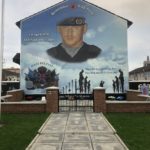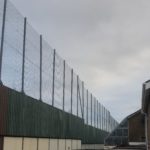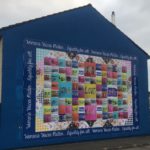What are we teaching our children?
This was the question repeatedly asked by our guide, Ciaran, on my family’s visit to Belfast earlier this month. We were on a black cab tour of the Protestant and Catholic neighborhoods of Belfast in an effort to better understand the deep communal divides that still permeate the city.
After stopping in front of a mural honoring Stephen McKeag, one of the deadliest unionist gunmen during The Troubles, Ciaran highlighted two important details. One, the mural had only just been installed in 2016. Two, it was right across the road from an elementary school.
“What are we teaching our children?” he asked.

The mural honoring Stephen McKeag
We drove past the gates separating the Falls and Shankill Road neighborhoods—the predominantly Catholic and Protestant communities—that are still locked every evening, interspersed along the 10-foot-high peace wall that separates the two communities.
“What are we teaching our children?”
We stopped to view the Clonard Martyrs Memorial Garden in the Falls neighborhood next to a home with a metal cage enclosing its back porch.
“What are we teaching our children?”

A house with a metal-caged back porch next to the peace wall
Many Protestants in Northern Ireland still grow up never knowing a Catholic, and many Catholics grow up never knowing a Protestant. Combined with narratives glorifying the sectarian violence of The Troubles, Ciaran saw no other possible outcome other than the perpetuation of misunderstanding and hatred.
Ciaran highlighted the work some in these communities are doing to fight against these trends. The Women’s Quilt mural in the Shankill neighborhood now promotes the voices of local women and their calls for peace, equality, and hope where a paramilitary mural once promoted division and sectarian resentment. To him, however, the murals and peace wall and interface gates represented the failure of Northern Irish society to reckon with its past and actively promote cross-community understanding. By perpetuating and glorifying division, how could society ever hope to find peace?

The Women’s Quilt mural
Listening to Ciaran describe the struggles of his city, I could not help reflecting on the divisions present in our own society in America. We in the US are more likely than ever to grow up among, consider friends, and even marry people who share the same political views as us. In fact, we are more geographically polarized than at any time since 1860—the year before the Civil War began. We are quick to paint those we disagree with using broad generalizations because we rarely make an effort to get to know those we disagree with. It is easier to stick with what we know, to remain in our ideological comfort zones. It is easier to promote the narrative of “us versus them” than to promote “us with them.”
Just like most in Northern Ireland, many Americans claim to be disgusted by hyper-polarization. But what are we teaching our children if we do nothing about it? In a thousand ways, the solutions to social division in Northern Ireland and the US are not the same, but I can say this: when we are incapable of recognizing the humanity of those unlike us, we forfeit the ability to form a productive society.
There are many questions that must be answered on the road to peace in Northern Ireland, and there are many too that must be answered as we seek to fight against divisions in America.
We would all be wise to start with this one: “What are we teaching our children?”
